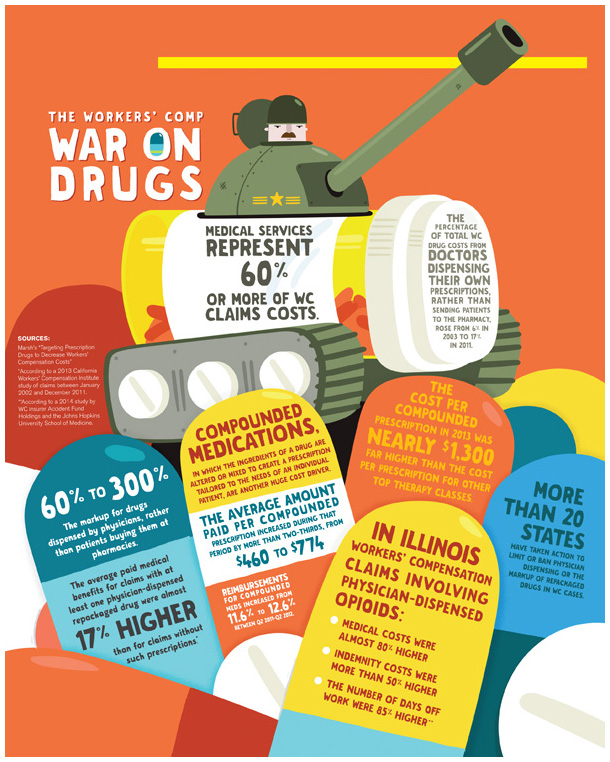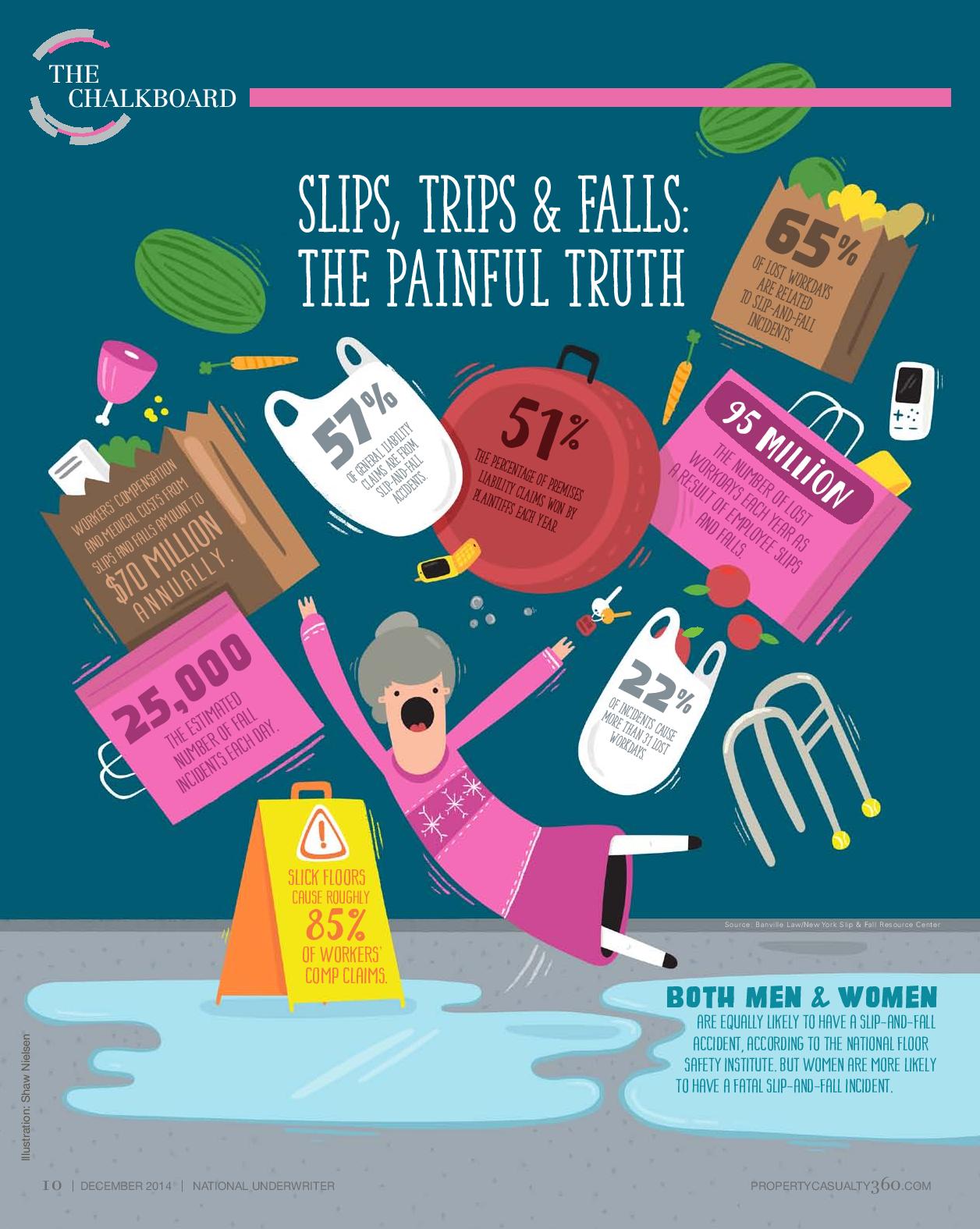Here is a look back on a year's worth of The Chalkboard, a recurring infographic that appears in each issue of National Underwriter Property & Casualty and every month on PropertyCasualty360.com.
Focusing on the insurance industry's most pressing market lines and trends, stats and facts are brought to focus with illustrations by Shaw Neilsen.
January
Slips, trips and falls are one of the leading causes of unintentional injuries, according to the National Safety Council. Common areas for falls to occur are in doorways, ramps, cluttered hallways, unstable work surfaces, ladders and stairs.
But how does this impact insurance? Click image to enlarge.
February
Agents place a higher priority on keeping and servicing existing customers than on finding new business, according to the results from the Accenture Independent Agent Survey. When asked to rate the most critical operational competencies, agents put "retaining customers" at the top of the list, followed by "servicing customers;" "attracting new customers" was ranked third.
Independent agents also say that the most valuable digital capability is effective carrier integration that is focused on web-based service and quoting. Other factors driving carrier selection include claims process quality and speed, underwriting appetite and pricing consistency.
Below, a summary of additional findings from the Accenture Independent Agent Survey. Click image to enlarge.
March
At 76.6 million, there are more millennials (born between 1981-1997, according to the Pew Research Center) than any other generation. Insurance agents need to know how to target this growing demographic, which holds $1.68 trillion in purchasing power.
Millennial consumers want insurance companies that provide the client-centric experience that they have become accustomed to, according to Applied Systems' "Why Millennials Matter" report. However, millennials still highly value in-person or over-the-phone experience with an agent. Below, a summary of findings from the report. Click image to enlarge.
April
Despite increasing awareness around cyber security and the increasing frequency of data breach events, risk professionals and insurance underwriters don't have a complete picture of the true impact of data security, as told by claims data, according to the NetDiligence 2014 Cyber Claims Survey.
The cyber risk consultants sampled 117 data breach insurance claims, from carriers that include ACE, AIG, Chubb, Lockton, Liberty International Underwriters, OneBeacon, Philadelphia, Travelers, XL Group and Zurich NA.
Below, a summary of the company's findings. Click image to enlarge.
May
Reducing medical costs can be one of the most effective ways to control the high price of Workers' Compensation programs, according to Marsh. Medical services now contribute to more than 60% of Workers' Comp claims, in part due to two cost drivers: physician dispensing and compounded drugs.
Below, a summary of findings from Marsh, the California Workers' Compensation Institute and insurer WC Accident Fund Holdings. Click image to enlarge.

June
According to the J.D. Power 2015 U.S. Insurance Shopping Study, many auto insurance customers are shopping for a new insurer, but surprisingly few are actually switching providers.
Auto insurers increased rates by an average of 2.1% nationwide in 2014, following an increase of 2.5% in 2013. Those rate hikes are contributing to customers shopping for a better deal. However, while more customers are shopping for a new insurer—39% in 2014 compared with 32% in 2013—only 29% actually switched in 2014, compared with 37% in 2013.
Below, a summary of the findings from J.D. Power. Click image to enlarge.
July
To assess risk management strategies among its members, RIMS conducted its first cyber survey, asking about insurance investments, exposures, cyber security ownership and government involvement, as well as identification methods and response procedures. The survey was answered by 284 of RIMS' professional members in the United States. The majority of the survey respondents represented organizations with more than $1 billion in revenue (58%), from a wide-range of industries, with most in manufacturing (16%) and financial services (13%).
Below, a summary of findings from the RIMS cyber survey. Click image to enlarge.
August
Insured losses in the U.S. for the first six months of the year totaled $8.2 billion, far below the past 15 years' average of $11.2 billion, according to Munich Re's "U.S. Natural Catastrophes – First Half of 2015" report.
The Eastern United States set a new record (in terms of original loss dollars) in winter storm damage, with $2.9 billion.
Across the country, severe thunderstorm events caused $5.1 billion in insured loss.
Below, additional findings from Munich Re's report. Click image to enlarge.
September
As much as $470 billion in life insurance and P&C insurance premiums will be up for grabs globally as a result of declining customer loyalty and the perceived commoditization of products, according to Accenture's report, "Capturing the Insurance Customer of Tomorrow."
"The study data indicates insurers are not keeping up with rising customer expectations, leading to increased customer dissatisfaction with insurance providers," said said John Cusano, senior managing director of Accenture's global Insurance practice in a statement. "This has created a 'switching economy,' which threatens traditional insurers by giving the advantage to companies most successful at exploiting digital technologies."
Below, a summary of Accenture's findings. Click image to enlarge.
October
Four out of five millennials are "optimistic" or "very optimistic" that the insurance industry will evolve to attract the next generation of insurance talent, due to productivity and efficiency gains from technology adoption, according to Vertafore's second annual "Millennial Revolution" study.
According to U.S. Census data, millennials outnumber baby boomers and are expected to make up half of the global workforce by 2020. However, insurance needs to find a way to make the industry attractive and leverage this talent.
Year-over-year comparisons show that work/life balance is the No. 1 reason why millennials stay in this industry, according to Vertafore. Nine out of 10 millennials also identify their company's use of technology, particularly mobile and social media, as key elements contributing toward job satisfaction. "Phones and tablets are the last thing millennials check before bed and the first thing they check in the morning. There's no question they're able to increase the productivity and throughput of employees, but there is a corollary—customers are also connected," Anthony Gomes, Vertafore's senior corporate communications manager, tells PC360. "The skyrocketing use of mobile technology should serve notice to leaders in companies that consumers expect access to companies on their own terms in timelines they define for themselves, and that millennials are always connected, looking for ways to drive new business through that technology."
Below, additional findings from Vertafore's report. Click image to enlarge.
November
While Americans' overall perception of their level of risk remained the same from 2014, their concerns over cyber risk in particular jumped by 21 percentage points, according to the results of the Travelers' 2015 Consumer Risk Index.
When it comes to risk perception, demographics such as location, gender, income and education matter to varying degrees. According to the survey, the majority of people who think the world is becoming riskier (57%) are women and individuals older than 40. Those with incomes above $50,000 see risk increasing.
Below, a summary of findings from Travelers' 2015 Consumer Risk Index. Click image to enlarge.
December
A number of personal Auto insurers will implement mid-single-digit rate increases over the next several quarters, to offset higher claim frequency and severity trends, according to the "P&C Personal Insurance — U.S. Outlook" from Moody's Investors Service. Current severity trends reflect new car sales at near-record levels, increased fraud, higher speed limits in certain states, pricier vehicle components and more serious accidents.
Moody's says to also expect low-to-mid-single-digit rate increases in the Homeowners' market, which will drive underlying margins and lower reinsurance costs.
Below, a summary of the findings from Moody's. Click image to enlarge.
Have you Liked us on Facebook?
Want to continue reading?
Become a Free PropertyCasualty360 Digital Reader
Your access to unlimited PropertyCasualty360 content isn’t changing.
Once you are an ALM digital member, you’ll receive:
- Breaking insurance news and analysis, on-site and via our newsletters and custom alerts
- Weekly Insurance Speak podcast featuring exclusive interviews with industry leaders
- Educational webcasts, white papers, and ebooks from industry thought leaders
- Critical converage of the employee benefits and financial advisory markets on our other ALM sites, BenefitsPRO and ThinkAdvisor
Already have an account? Sign In Now
© 2024 ALM Global, LLC, All Rights Reserved. Request academic re-use from www.copyright.com. All other uses, submit a request to [email protected]. For more information visit Asset & Logo Licensing.



















